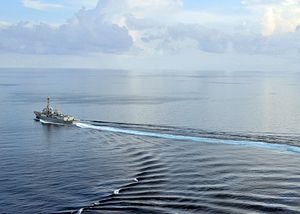This weekend, two U.S. warships conducted a lawful transit of the Taiwan Strait, the waterway separating mainland China from Taiwan. Two U.S. Arleigh Burke-class guided missile destroyers homeported in Japan, USS Mustin and USS Benfold, transited the strait.
Under circumstances anywhere else, the lawful passage of warships through the high seas shouldn’t be news, but the geopolitical circumstances of the Taiwan Strait ensure that any U.S. warship presence in the area draws scrutiny.
“Two U.S. Navy ships conducted a routine transit through the international waters of the Taiwan Strait on July 7-8,” a spokesperson for the U.S. Pacific Fleet noted in a statement released to the U.S. Naval Institute News. “U.S. Navy ships transit between the South China Sea and East China Sea via the Taiwan Strait and have done so for many years.”
China’s nationalist-leaning Global Times, a non-authoritative but state-linked publication, lashed out predictably, charging the United States with “aggravating Taiwan Strait tensions” in a tweet. It also implied that Chinese People’s Liberation Army-Navy vessels monitored the passage of the U.S. warships through the strait.
The transits of the two destroyers over the weekend might mark the start of a sustained drumbeat of similar transits, emphasizing the United States’ commitment to Taiwan amid intensifying Chinese pressure on the island, which is led by the independence-leaning government of President Tsai Ing-wen. The U.S. had been considering these kinds of transits since at least June and possibly earlier this year.
Since 2016, China has been gradually applying pressure on Taiwan’s diplomatic partners, resulting in at least six countries switching their diplomatic recognition to Beijing from Taipei. Only 18 states continue to maintain diplomatic ties with Taiwan today. Beijing’s pressure campaign on Taipei has also extended to other countries and even the private sector.
The destroyer transits also come following several moves by the United States to apply pressure on China broadly in the security realm. Beginning in May, the United States disinvited the PLAN from this year’s Rim of the Pacific multilateral naval exercise, the world’s largest, and U.S. Defense Secretary Jim Mattis vocally criticized China’s militarization of features in the South China Sea at the Shangri-La Dialogue in Singapore in early June.
The U.S. administration may choose to undertake further steps in support of Taiwan. One of the proposals that is reportedly under consideration is a port call by a U.S. Navy vessel to Kaohsiung.
The Taiwanese Ministry of National Defense has not formally proposed reciprocal port calls with the U.S. Navy, but has hinted that it could do so in the future. Such port calls have not taken place since the 1970s. The Chinese Foreign Ministry has criticized the idea and at least one Chinese diplomat has threatened that China could take kinetic action of some sort if a U.S. Navy vessel were to visit Kaohsiung.

































